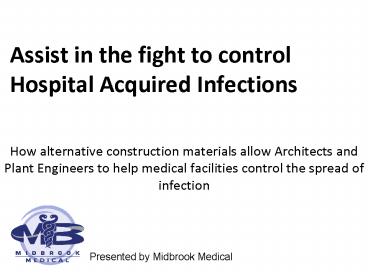Assist in the fight to control Hospital Acquired Infections - PowerPoint PPT Presentation
1 / 27
Title:
Assist in the fight to control Hospital Acquired Infections
Description:
... vascular lines, urine catheterization), and antibiotic use and prophylaxis. ... A strain of staph resistant to broad spectrum antibiotics. C. difficile ... – PowerPoint PPT presentation
Number of Views:374
Avg rating:3.0/5.0
Title: Assist in the fight to control Hospital Acquired Infections
1
Assist in the fight to control Hospital Acquired
Infections
- How alternative construction materials allow
Architects and Plant Engineers to help medical
facilities control the spread of infection
Presented by Midbrook Medical
2
Hospital Acquired Infection
- It is estimated that HAI costs to hospitals in
the United States range from 5 to 10 Billion
every year. - Hospital-acquired infections (HAIs), also known
as health-careassociated infections, encompass
almost all clinically evident infections that do
not originate from a patient's original admitting
diagnosis - Infections are estimated to occur in 5 of all
acute-care hospitalizations
3
Causes of HAI
- There are three different main causes of HAIs
- Atrogenic risk factors include pathogens on
the hands of medical personnel, invasive
procedures (intubation and extended ventilation,
indwelling vascular lines, urine
catheterization), and antibiotic use and
prophylaxis. - Organizational risk factors include contaminated
air-conditioning systems, contaminated water
systems, microbial sustaining work surfaces,
staffing and physical layout of the facility
(nurse-to-patient ratio, open beds close
together). - Patient risk factors include the severity of
illness, underlying immunocompromised state, and
length of stay.
4
Types of HAI
- Staph Staphylococcus Aureus
- Easily transmitted by touching infected surfaces
- The most common cause of Staph Infections
- MRSA Methicillin-resistant Staphylococcus
aureus - Common in hospitals 10.1 infections per 100,000
patients in 2005 (AMA 2007 Vol298 15) - A strain of staph resistant to broad spectrum
antibiotics - C. difficile
- Bacterium that can cause symptoms ranging from
diarrhea to life-threatening inflammation of the
colon - Most commonly affects older adults in hospitals
or long term care facilities
5
Controlling Infection
- Replacing materials which easily harbor HAI can
reduce the instances of infection in a hospital. - New advances in technology have resulted in
multiple alternatives to traditional surface
materials. - New materials actively fight infection.
6
Particle Board
- Absorbs water easily
- Moisture causes warping
- Damaged surfaces can become breeding grounds for
microbial growth
7
Caulk Gaps
Standing Water
Damaged Plastic Laminate
Exposed Particle Board
8
Board swollen and structurally unstable
Mold growth penetrating surface
9
Exposed Particle Board in Work Environment
10
Exposed Particle Board in Work Environment
11
Proposal for Change
- Eliminate particle board under work surfaces
counter tops in patient areas, sterile cores,
support areas such as sterile processing prep,
food service, equipment / supply support - Eliminate Plastic Laminate Cabinets in patient
areas, sterile cores, support areas such as
sterile processing prep, food service,
equipment / supply support
12
Proposal for Change
- Eliminate porous materials such as surface
substrate materials in patient areas, sterile
cores, support areas such as sterile processing
prep, food service, equipment / supply support - Expand AIA Minimum Standards 2.1.A2 to include
patient areas, sterile cores, support areas
such as sterile processing prep, food service,
equipment / supply support sterile cores.
Current standards do not apply to these areas.
13
Stainless Steel
Custom OR Cabinetry by Midbrook
14
Stainless Steel
- Pros
- Non-porous
- Does not absorb moisture
- Cons
- Does act as anti-microbial agent
- Low sound absorption
- More difficult to clean
15
Custom Stainless Steel Workstation
16
Stainless Steel Cart
17
Stainless Steel Table
18
Corian Solid Surfaces
19
Corian Solid Surfaces
- Pros
- Smooth, non-porous surface
- Does not absorb moisture
- Easy to clean
- Durable, easy to repair
- Cons
- Does not actively fight microbial growth
20
Corian Scrub Sink
21
Corian Countertops
22
Survivability of Pathogens
Survival rates are dependent on type of surface,
environmental conditions, presence of biofilm,
and other factors.
Information provided by the DuPont Corporation
23
Copper
24
Copper
- Pros
- Fights microbial growth
- Is as easy to form and manufacture as stainless
steel in custom fabrications - Cons
- Depending on alloy ratio of copper to other
metals, the copper may tarnish after long term
exposure.
25
Copper
- A clean copper surface is capable of killing
99.9 of bacteria exposed to the surface within 2
hours from time of initial exposure. - Copper is biostatic. That means bacteria will not
grow on its surface. Copper and copper alloy
doorknobs protect against the transfer of disease
in hospitals.
26
Copper Products
27
Copper Products































